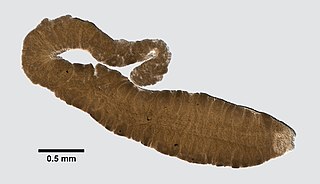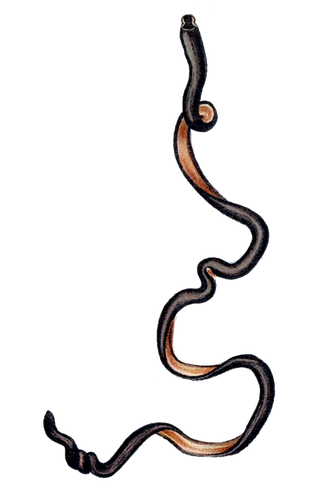
Nemertea is a phylum of animals also known as ribbon worms or proboscis worms, consisting of 1300 known species. Most ribbon worms are very slim, usually only a few millimeters wide, although a few have relatively short but wide bodies. Many have patterns of yellow, orange, red and green coloration. The foregut, stomach and intestine run a little below the midline of the body, the anus is at the tip of the tail, and the mouth is under the front. A little above the gut is the rhynchocoel, a cavity which mostly runs above the midline and ends a little short of the rear of the body. All species have a proboscis which lies in the rhynchocoel when inactive but everts to emerge just above the mouth to capture the animal's prey with venom. A highly extensible muscle in the back of the rhynchocoel pulls the proboscis in when an attack ends. A few species with stubby bodies filter feed and have suckers at the front and back ends, with which they attach to a host.
A planula is the free-swimming, flattened, ciliated, bilaterally symmetric larval form of various cnidarian species and also in some species of Ctenophores, which are not related to cnidarians at all. Some groups of Nemerteans also produce larvae that are very similar to the planula, which are called planuliform larva. In a few cnidarian clades, like Aplanulata and the parasitic Myxozoa, the planula larval stage has been lost.

Anopla has long been used as name for a class of marine worms of the phylum Nemertea, characterized by the absence of stylets on the proboscis, the mouth being below or behind the brain, and by having separate openings for the mouth and proboscis. The other long used class of Nemertea are the Enopla. Although Anopla is a paraphyletic grouping, it is used in almost all scientific classifications. Anopla is divided into two orders: Palaeonemertea and Heteronemertea.

Palaeonemertea is a class of primitive nemertean worm. It may be para- or polyphyletic, consisting of three to five clades and totalling about 100 species.

Enopla is one of the classes of the worm phylum Nemertea, characterized by the presence of a peculiar armature of spines or plates in the proboscis.

Parborlasia corrugatus is a proboscis worm in the family Lineidae.. It was formerly placed in family Cerebratulidae. This species of proboscis or ribbon worm can grow to 2 metres in length, and lives in marine environments down to 3,590 metres (11,780 ft). This scavenger and predator is widely distributed in cold southern oceans.

Lineidae is a family of nemertean worms. It contains the following genera:
Prostoma jenningsi is a species of ribbon worm known only from one site near Croston, Lancashire. It was described in 1971, and is believed to be the county's only endemic species. It grows up to 20 mm (0.8 in) long, with 4–6 black eyespots, and has a long eversible proboscis.
Gononemertes australiensis is a parasitic ribbon worm. It lives commensally in the ascidian Pyura pachydermatina found in the sublittoral waters of the New Zealand. G. australiensis was found in specimens of P. pachydermatina collected in Sydney harbor. These worms were found specifically in the atrium of P. pachydermatina. It is dioecious and has several gonads. Each of its gonads produce several oocytes while the male worms carry testes along its parenchyma. Fertilization is external.

Malacobdellidae is a monogeneric family within the phylum Nemertea. It is included with the order Hoplonemertea within the class Enopla.
Antiponemertes is a genus of nemertean worms that contains the following species:
Lineus sanguineus, the banded nemertean or social lineus, is a species of nemertean ribbon worm in the family Lineidae. It occurs in the northeastern Atlantic Ocean as well as on both coasts of North America. It burrows in muddy sand from the mid-tidal zone downwards and conceals itself in crevices and under stones.
Carcinonemertes errans is a ribbon worm in the family Carcinonemertidae. It lives in symbiosis with the Dungeness crab, consuming the crab's developing eggs. In 1980 it was implicated in the collapse of the Dungeness crab fishery in central California.
Notospermus is a genus of nemertine worms that includes marine species. Genus contains the following species:
Prostoma eilhardi is a species of ribbon worm. This species uses ciliary gliding to get from place to place. It is closely related to Prostoma graecense. The species has been classified as androdioecious.

Prostoma graecense is a species of Nemertea in the family Prostomatidae. It was once called Emea rubrum. It is closely related to Prostoma eilhardi. The species is distributed all across the world.

Geonemertes pelaensis is a species of terrestrial Nemertea. Superficially, Geonemertes pelaensis resembles a land flatworm and lives in the same habitat, but it has an anterior exertile proboscis, whereas flatworms have a pharynx located in their ventral side at midlength of body. The number of eyes this nemertean can have varies between 4 and 8 ocelli.

Paranemertes peregrina is a species of Nemertea, or ribbon worm, in the family Neesiidae.

Argonemertes dendyi is a species of enoplan; one of just twelve known species of land-dwelling ribbon worms.









